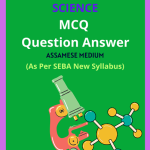Class 8 Science MCQ Chapter 12 Friction Solutions in English Medium, Class 8 Science Multiple Choice Question Answer in English to each chapter is provided in the list so that you can easily browse throughout different chapters Class 8 Science MCQ Chapter 12 Friction Notes and select need one.
Class 8 Science MCQ Chapter 12 Friction
Also, you can read the SCERT book online in these sections Class 8 Science Objective Type Solutions by Expert Teachers as per SCERT (CBSE) Book guidelines. These solutions are part of SCERT All Subject Solutions. Here we have given Assam Class 8 Science MCQs Solutions in English for All Subject, You can practice these here.
Friction
Chapter – 12
| MCQ |
1. What is the force that opposes the motion of an object sliding over a surface?
(a) Gravitational force.
(b) Normal force.
(c) Frictional force.
(d) Tension force.
Ans: (c) Frictional force.
2. Which type of friction occurs when two surfaces are moving relative to each other?
(a) Static friction.
(b) Kinetic friction.
(c) Rolling friction.
(d) Fluid friction.
Ans: (b) Kinetic friction.
3. Which type of friction is generally greater, static or kinetic?
(a) Static friction.
(b) Kinetic friction.
(c) Both are equal.
(d) It depends on the surfaces.
Ans: (a) Static friction.
4. The coefficient of friction is a measure of:.
(a) The strength of the normal force.
(b) The amount of heat generated.
(c) The roughness of the surfaces in contact.
(d) The mass of the object.
Ans: (c) The roughness of the surfaces in contact.
5. What happens to the frictional force when the normal force increases?
(a) It decreases.
(b) It remains unchanged.
(c) It increases.
(d) It becomes zero.
Ans: (c) It increases.
6. What is the term for the frictional force that opposes the motion of a rolling object?
(a) Static friction.
(b) Kinetic friction.
(c) Rolling friction.
(d) Fluid friction.
Ans: (c) Rolling friction.
7. Which of the following factors does not affect the magnitude of friction?
(a) Surface area of contact.
(b) Nature of the surfaces.
(c) Normal force.
(d) Coefficient of friction.
Ans: (a) Surface area of contact.
8. If the coefficient of friction is 0.4 and the normal force is 500 N, what is the frictional force?
(a) 200 N.
(b) 100 N.
(c) 500 N.
(d) 400 N.
Ans: (d) 200 N.
9. Frictional force is independent of:
(a) The weight of the object.
(b) The type of materials in contact.
(c) The speed of the object.
(d) The roughness of the surfaces.
Ans: (c) The speed of the object.
10. In which of the following scenarios is friction minimized?
(a) Sliding a box on a concrete floor.
(b) Rolling a ball on a smooth surface.
(c) Pushing a heavy object on a rough surface.
(d) Dragging a sled through snow.
Ans: (b) Rolling a ball on a smooth surface.
11. The maximum frictional force before an object starts moving is called:
(a) Kinetic friction.
(b) Static friction.
(c) Dynamic friction.
(d) Rolling friction.
Ans: (b) Static friction.
12. What type of friction occurs between a fluid and a solid surface?
(a) Static friction.
(b) Kinetic friction.
(c) Rolling friction.
(d) Fluid friction.
Ans: (d) Fluid friction.
13. When a car goes around a curve, the frictional force that prevents it from skidding is:
(a) Static friction.
(b) Kinetic friction.
(c) Rolling friction.
(d) Fluid friction.
Ans: (a) Static friction.
14. Frictional force is directly proportional to:
(a) The area of contact.
(b) The weight of the object.
(c) The speed of the object.
(d) The distance traveled.
Ans: (b) The weight of the object.
15. If two surfaces are perfectly smooth, what type of friction exists between them?
(a) Static friction.
(b) Kinetic friction.
(c) No friction.
(d) Rolling friction.
Ans: (c) No friction.

Hi! my Name is Parimal Roy. I have completed my Bachelor’s degree in Philosophy (B.A.) from Silapathar General College. Currently, I am working as an HR Manager at Dev Library. It is a website that provides study materials for students from Class 3 to 12, including SCERT and NCERT notes. It also offers resources for BA, B.Com, B.Sc, and Computer Science, along with postgraduate notes. Besides study materials, the website has novels, eBooks, health and finance articles, biographies, quotes, and more.




